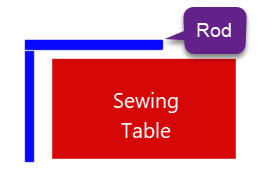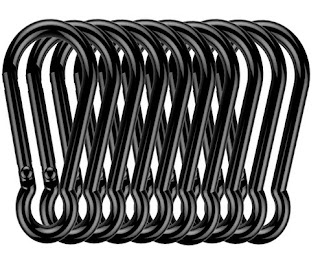Here's my wall of 3" Economy Blocks. I have been making them using foundation paper piecing. I was evaluating my color values, so this is a desaturated picture.
My goal in piecing this block was to systematically use up some fabric in a colorway leftover from another quilt. I don't care for the colorway, though it made a lovely quilt. Moreover, it made lovely economy blocks. A 3" economy block makes a perfect center for a 9" finished 9 patch. For example, you can make a 6" finished Sawtooth Star, which sports a 3" finished center. I love the Sawtooth star, but I decided that I was ready to use my Tri-Tool ruler, and I was going to make V Blocks (Deb Tucker's name for it), Tri-Rec (name of the tool to make, it is a square block), or the older name Peaky and Spike.
Here's my test block (unsewn).
You can see that I have MANY economy blocks on the wall (59) and many more to finish. Let's round to 60 for discussion. I have 240 (60 x 4) blocks to make to make the 9 patch above. Though I have not settled on other renditions, this is just a first pass. Nevertheless, I have several maker's notes to consider if you are faced with a daunting amount of blocks to make. (And how cute are these blocks for mug rugs or hot pads?). These notes will get you in Henry Ford production mode if you are tackling a large project.
First: Get a ruler dedicated for this. For less than $15 you can get a high quality ruler that will help you to make this block. This ruler will allow you to make the triangle in square as well as split rectangle block by joining two mirrored pieces of the side triangle.
💣💣 Don't be tempted to use your 60 degree ruler here. The angle is 53.5 degrees--a difference worth noting.
There are many ways to skin the quilt cat. As I have to make so many of 3" finished blocks, I was figuring out my production method to put these in a 9 patch with an economy block at the center. As always, making a test block is important advice. I had to use a scant 1/4" to get my block to measure 3.5" across. Using a perfect 1/4" put me a wee bit short. Different fabrics and thread will dictate your small adjustments needed.
- I actually have two rulers--Deb Tucker's V Block and Darlene Zimmerman's Tri-Tool ruler. Either ruler works, and my duplication of the tool was by accident. Having a ruler to do this is almost an imperative. I will note that Deb Tucker's ruler makes the perfect trim down ruler, although once you get your seam width correct, there are only dog ears to nip off. As it is a common block, why not make an investment in accuracy and ease?
- Tri-Tool or Tri-Recs ruler not only makes the square blocks as demonstrated here, but also the proportional rectangle blocks (2 x tall as wide)--simply by using the side ruler and creating mirrored blocks.
- Use a helper ruler for awkward left sided cuts: Using a helper ruler butted on the left hand side allows for an easy cut on that end without reaching around. This ruler comes with its own helper...the center triangle is the helper for the side triangle and the side triangle is the helper for the center triangle. Using a helper ruler works so much easier than turning the fabric about--I don't know why it is not demonstrated more.
- (Here's the money shot!). The side triangles can be cut from a rectangular piece of fabric: Okay, you know what that means. If you cut a proper sized rectangle, you make one ruler alignment, one cut, and if you have stacked your fabric (right/wrong sides together), you will have 2 mirrored units (mirror from the top and bottom fabric. If you cut one layer, you will get the same "side". So if you cut one layer, you will have to flip your ruler on its backside on each alternate cut. That is a waste of time in my view.
- How to figure a proper sized rectangle? Easy. Simply make 2 cuts to get two pieces. Align the first cut with straight line on the left. Second cut, rotate your ruler. Now butt these together and measure (see bottom of this post for better visual). That is the width of your rectangle. The height is dictated by the called for strip size for the unit that you are making.(You could trace on paper and measure that way too).
- I have 3" finished blocks (trim size 3.5"). I have LOTS of these to do. The proper sized rectangle for me is 2 5/8ths. The strip width needed is 3.5".
- I reverse engineered my cuts. (See below). I cut my strip at 2 5/8 wide (awkward size cut once), put wrong sides together for mirror and used my Stripology ruler to make the 3.5" subcuts.
- Itty Bitty Eighths ruler works well when dealing with eighths has it has a line to easily follow.
- With my rectangles perfectly sized, I made ONE alignment with my side rectangle, and with one cut, I had 2 pairs of perfectly mirrored side triangles. You can see what a time saver this is!
- The side nick on the tool is easily accomplished by just nicking the corner (sans the tool) with your rotary cutter and avoids the awkward nick using the tools. Once you've used the tool, you will be comfortable doing this.
- Marti Michell's Deluxe Corner Trimmer has an angle for the Peaky and Spike. If you use that to cut the top of your side triangle, (v knicking the bottom), it will line up perfectly with the top of the center triangle. This method would work well if you had a different tool.
- There is NO wasted fabric using this method. For just a few sides, simply cut a smaller piece of fabric; you don't have to work with a full strip. This cutting coupled with glue basting (note 4) would make Henry Ford envious of your production rates.Note 3: I have a corner cutting tool (Marti Michell's Deluxe Corner Trimmer) that has a corner for the peaky/spike block--which is what this block is also known as. It cuts the top tip so that it aligns perfectly across the top (v. the bottom). (It's a fab tool that has many uses! It's an observation and a work preference. The little nick on this tool allows perfect alignment.
- Glue basting is
a great way to produce a lot of blocks, in addition to the cutting
methods noted above. Glue baste one side to the triangle (run a bead of
glue, place the side to the triangle, and quickly heat set. You can
stack up a number of these, and then chain piece. Press open, and then
rinse and repeat on the other side. This method also has the advantage
of stabilizing the bias on both pieces. (I use the method for Diamond
Rectangles as well)
- When working with triangles (regardless of the tool), some tools have a flat tip, some have a pointy tip. Accordingly, block construction/strip widths WILL (not may) vary if you use a pointy v. a blunt tip without modifying your strip width. Marcie Baker has a great video on this. As a newer quilter a couple of years ago, I did not understand how rulers differed in this regard.
How to cut your side pieces en masse using a triangle:
Here is a segmented piece for a 3" block. I cut it from a 2 5/8" WOF cut using my Itty Bitty Eighths Ruler which has the 1/8th marks with continuous dashes (easy to line up). I subcut the strip using my GE Designs Striplogy ruler. Quick. Accurate.
Now let's align our side triangle.
Now let's make the cut
You can see the little nick in the tool on the upper left. I choose to freehand nick. One alignment; one cut; 2 freehand nicks.
💡 The above image give you a visual for figuring out the initial size. For my TEST, I cut a 3.5 piece of fabric, made my first cut, and then rotated the ruler clockwise one rotation to make the second cut on the right hand side. Mushing the two together and measuring the width, tells you the width that you need for your rectangle. In my case, it is 2 5/8ths. I cut my strip using this odd measure, and then subcut with Stripology ruler to make the on the 1/2" cuts (3.5 in my case). It is a real time saver.
Pretty nifty, don't you think?
Wait, wait, there is more. (This is updated, my first table had errors that I did not catch).
Here are my measures for the rectangles. As you can see for every 1" increment in the strip size, the width increases 1/2". The reason...there is a 2:1 ratio of height to width. Note, too, that the point measures 1/2 inch.
I should note that the real math is this: strip width/2 + .75". But for the Tri Recs tool, I found that the extra 1/8" allowed for better service due to alignment of ruler, paralax and all that stuff.
Align once; cut once; nick twice.
In the end, though, I would recommend Deb Tucker's V Block over this tool. This is a precision block with precision points and there is bias...accordingly, my adopted best practice is to slightly oversize and trim down. That way, I have 100% success rate (unless I fall asleep at trimming) on making a perfectly balanced (across bias lines) and perfectly sized block.





























